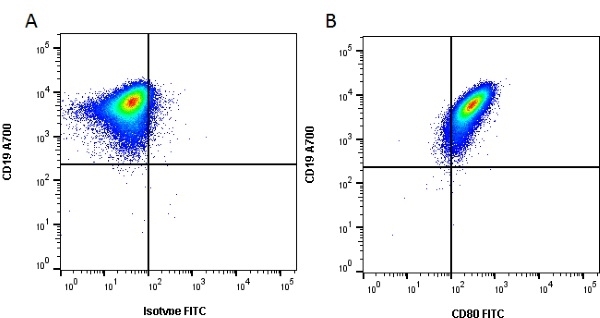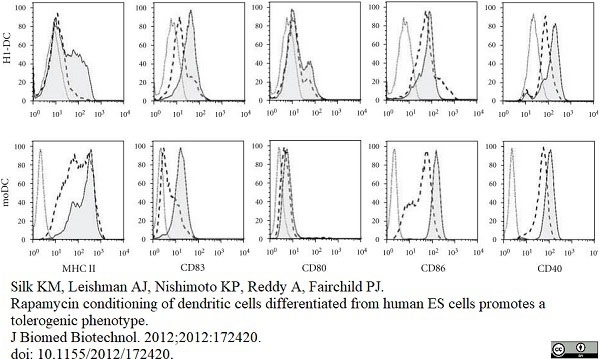CD80 antibody | MEM-233


Mouse anti Human CD80
- Product Type
- Monoclonal Antibody
- Clone
- MEM-233
- Isotype
- IgG1
- Specificity
- CD80
| Mouse anti Human CD80 antibody, clone MEM-233 recognizes human CD80, also known as B7-1, a ~60 kDa type 1 trans-membrane protein expressed of macrophages, dendritic cells (Munro et al. 1994) and activated B-cells (Ranheim et al. 1993). CD80 is a member of the immunoglobulin superfamily having an extracellular domain bearing both a single Ig-v-like domain, a single Ig-c-like domain, a transmembrane sequence and a short cytoplasmic domain. Although the predicted molecular weight for human CD80 is ~33 kDa, the presence of multiple (8) potential N-glycosylation sites (Chen et al. 1998) results in a migration corresponding to ~60 kDa. Human CD80 along with CD86 act as co-stimulatory molecules and are both ligands for CD28 and CTLA-4 (Azuma et al. 1993) involved in T cell activation and proliferation (Vasu et al. 2003). Although CD80 binds to the same receptors as CD86 it displays quite different characteristics in its avidity and binding kinetics (van der Merwe et al. 1997). Mutagenesis indicates residues in both the Ig-v-like and Ig-c-like domains of CD80 are crucial for the interaction with it’s receptors CTLA-4 and CD28 (Peach et al. 1995). Mouse anti human CD80 antibody, clone MEM-233 binds to residues within the Ig-v-like domain of human CD80 as shown by domain switching assays (Vasu et al. 2003). Mouse anti Human CD80, clone MEM-233 in combination with Mouse anti Human CD86, clone Bu63 (MCA1118) suggest that clone MEM-233 is able to block binding of human CD80 with it's cognate ligands CD28 and CTLA-4 (Morbach et al. 2011). |
- Target Species
- Human
- Product Form
- Purified IgG - liquid
- Preparation
- Purified IgG prepared by affinity chromatography on Protein A from tissue culture supernatant
- Buffer Solution
- Phosphate buffered saline
- Preservative Stabilisers
- 0.09% sodium azide (NaN3)
- Approx. Protein Concentrations
- IgG concentration 1.0 mg/ml
- Regulatory
- For research purposes only
- Guarantee
- 12 months from date of despatch
Avoid repeated freezing and thawing as this may denature the antibody. Storage in frost-free freezers is not recommended.
| Application Name | Verified | Min Dilution | Max Dilution |
|---|---|---|---|
| Flow Cytometry | |||
| Immunoprecipitation | |||
| Western Blotting | Non-reducing conditions |
- Flow Cytometry
- Use 10μl of the suggested working dilution to label 106 cells or 1007mu;l whole blood
| Description | Product Code | Applications | Pack Size | List Price | Your Price | Quantity | |
|---|---|---|---|---|---|---|---|
| Mouse IgG1 Negative Control | MCA928 | F | 100 Tests |
|
Log in | ||
| List Price | Your Price | ||||||
|
|
Log in | ||||||
| Description | Mouse IgG1 Negative Control | ||||||
References for CD80 antibody
-
Zhan, H. et al. (2003) The immunomodulatory role of human conjunctival epithelial cells.
Invest Ophthalmol Vis Sci. 44 (9): 3906-10. -
Tan, P.H. et al. (2004) Phenotypic and functional differences between human saphenous vein (HSVEC) and umbilical vein (HUVEC) endothelial cells.
Atherosclerosis. 173: 171-83. -
Huxley, P. et al. (2004) High-affinity small molecule inhibitors of T cell costimulation: compounds for immunotherapy.
Chem Biol. 11: 1651-8. -
Tan, P.H. et al. (2005) Modulation of human dendritic-cell function following transduction with viral vectors: implications for gene therapy.
Blood. 105: 3824-32. -
Angel, C.E. et al. (2006) Cutting edge: CD1a+ antigen-presenting cells in human dermis respond rapidly to CCR7 ligands.
J Immunol. 176 (10): 5730-4. -
Daubenberger, C.A. et al. (2007) Flow cytometric analysis on cross-reactivity of human-specific CD monoclonal antibodies with splenocytes of
Aotus nancymaae, a non-human primate model for biomedical research.
Vet Immunol Immunopathol. 119 (1-2): 14-20. -
Trojan, J. et al. (2010) Antisense anti IGF-I cellular therapy of malignant tumours: immune response in cancer patients.
Biomed Pharmacother. 64: 576-8. -
Piconi, S. et al. (2010) Immunological effects of sublingual immunotherapy: clinical efficacy is associated with modulation of programmed cell death ligand 1, IL-10, and IgG4.
J Immunol. 185: 7723-30.
View The Latest Product References
-
John, J. et al. (2010) Differential effects of Paclitaxel on dendritic cell function.
BMC Immunol. 11: 14. -
Hovden, A.O. et al. (2011) Maturation of monocyte derived dendritic cells with OK432 boosts IL-12p70 secretion and conveys strong T-cell responses.
BMC Immunol. 12: 2. -
Silk, K.M. et al. (2012) Rapamycin conditioning of dendritic cells differentiated from human ES cells promotes a tolerogenic phenotype.
J Biomed Biotechnol. 2012: 172420. -
Silk, K.M. et al. (2012) Cross-presentation of tumour antigens by human induced pluripotent stem cell-derived CD141+XCR1+ dendritic cells
Gene Ther. 19: 1035-40. -
Demmers, M.W. et al. (2013) Differential effects of activated human renal epithelial cells on T-cell migration.
PLoS One. 8 (5): e64916. -
Scott-Taylor, T.H. et al. (2017) Enhanced formation of giant cells in common variable immunodeficiency: Relation to granulomatous disease.
Clin Immunol. 175: 1-9.
- Synonyms
- B7-1
- RRID
- AB_323471
- UniProt
- P33681
- Entrez Gene
- CD80
- GO Terms
- GO:0005515 protein binding
- GO:0016021 integral to membrane
- GO:0035556 intracellular signal transduction
- GO:0007267 cell-cell signaling
- GO:0009967 positive regulation of signal transduction
- GO:0015026 coreceptor activity
- GO:0016563 transcription activator activity
- GO:0031295 T cell costimulation
- GO:0042110 T cell activation
- View More GO Terms
- GO:0044419 interspecies interaction between organisms
- GO:0045086 positive regulation of interleukin-2 biosynthetic process
- GO:0045425 positive regulation of granulocyte macrophage colony-stimulating factor biosynthetic process
- GO:0045627 positive regulation of T-helper 1 cell differentiation
- GO:0050731 positive regulation of peptidyl-tyrosine phosphorylation
MCA2071GA
MCA2071
If you cannot find the batch/lot you are looking for please contact our technical support team for assistance.
Please Note: All Products are "FOR RESEARCH PURPOSES ONLY"
View all Anti-Human ProductsAlways be the first to know.
When we launch new products and resources to help you achieve more in the lab.
Yes, sign me up
